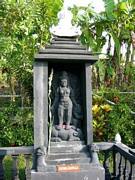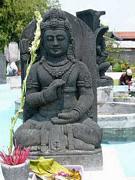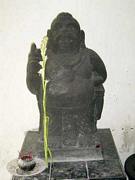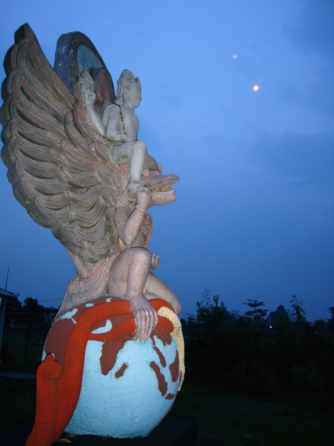About YOGA
We will start by establishing certain basic definitions. Yoga means “union”: the union of human consciousness with divine consciousness. In reality these are not separate because ultimately everything is Spirit or God, and God or Spirit is One. Yoga refers to the methods used to consciously attain the practical realization of this union. Tantra, which will be discussed later, refers to two things:
- the practical teaching regarding the centers of consciousness in the body, called chakras, of which seven are traditionally emphasized;
- the practice of yoga through concentration on the first chakra, which in males is contacted at the perineum and in females at the cervix, with the purpose of consciously arousing the power of existence or being in the human body, called Kundalini, which lies dormant in the first chakra.
One of the immediate goals of this yogic system is to see and communicate with the Higher Self, the blue or golden self, the True Teacher. In the path towards union, the ego or worldly self cannot directly approach angelic or divine consciousness: the ego must first identify with the Higher Self, which can then approach the spiritual principles or deities.
From the viewpoint of human consciousness, we will analyze three interrelated aspects and their corresponding yogic techniques used traditionally in Java.
The first aspect to be mentioned views all manifestation as energy. Energy is manifested in two patterns: that of the wave and that of the spiral. The former seen from a horizontal viewpoint is experienced as an off-on sequence. The latter is experienced as cycles.
This energy as we observe it is electro-magnetic in character. It exists in the human body and in all of nature. It has three types, positive, negative, and neutral. In humans, the positive energy is experienced as the life of the body, controlling the physiological functions. The negative energy is experienced as the life of the senses, controlling emotional and subtle functions. The neutral is experienced as the lower mental functions. Specific yogic techniques exist in Java leading to knowledge of and control of these streams of energy.
The negative energy is developed through a water meditation, which involves submerging oneself in water up to the neck at night, using a specific position or mudra. Traditionally, this was done in natural running water, for example, sacred springs or ponds or places where two streams or rivers met. On the psychological plane, the emotional system becomes stabilized. Seen yogically, the nadis (subtle nerves) are straightened out. This eventually leads to the ability to perceive emotions as energy so as to control them and not be controlled by them. For example, anger is produced as a particular reaction to red energy. When this energy is seen or felt before a personal identification and reaction to it is made, it can be used or transformed. In this case, the person can use the energy consciously without experiencing anger. In this process, past and latent illnesses caused by emotional strain or tension are briefly experienced and their effect or residue is cleaned out. Ultimately, the purpose of this exercise is to transform the energy, which is normally used for emotions, in order to use it for the spiritual quest.
The positive energy is approached by sun-gazing. In this case, residues of past illnesses and potential illnesses with a physiological cause are cleaned out. This positive energy is what drives the instincts or the will to live (the life instinct) and the will to die (the death instinct). Again, the ultimate yogic goal is to borrow the instinctual energy so it can be used for the quest.
The neutral energy is approached mainly through a heart meditation, a candle-gazing exercise, and other exercises, one aim being to still the activity of the lower mind. Again, the energy used for mental functioning will be borrowed.
The second aspect is the life energies seen as a composite of four types of energy. According to Javanese tradition, when we are born, four types of energy, corresponding to the four subtle elements, each with its own color, are formed, their purpose being to protect the new human. From the spiritual point of view these energies must be transformed, since self and, later, ego protection are tendencies which must be transcended. These energies can be seen with the inner vision to have the same shape as the person. They are called the four siblings.
The black self, connected with the element of earth, is expressed in its negative form as hatred. From the ego point of view, it is the principle of separateness, protecting the good “us” from the bad “them”. This can be transformed into talent at psychic things or secret knowledge.
The yellow self, corresponding to water, in its negative aspect expresses itself as lust. It can be transformed into wisdom.
The red self, corresponding to fire is expressed negatively as anger. It can be transformed into pure energy.
The white self, corresponding to air, is expressed in its negative aspect as sterility. It can be transformed purity, which in human life means self-sacrifice or longing for the Spirit.
In yoga, all of the siblings, even in their positive form, must be controlled and quiescent, as one turns away from worldly experience towards the Spirit. Only when these energies are dormant can the seeker know the spiritual energies which are seen as blue, golden, or a combination of the two, a certain green.
The third aspect is the system of power centers in the body, known as chakras. These centers obviously are not in the physical body but are initially approached through corresponding points in it. As the human being is seen to be a potentially perfect microcosm, it is through exploration of these centers that we can experience the multiple levels of being. The outer levels must be made dormant to approach the inner ones. The process is like peeling the layers of skin off an onion, so the spiritual seeker can reach identification with the divine principles in each chakra.
These three yogic aspects have two immediate goals: the personal experience of the identification with the Higher Self and the arousal of the Kundalini energy. Kundalini is the Power of Creation in the microcosm, i.e., the human system. It is dormant in the first chakra. This spiritual quest requires vast amounts of energy. Most of the necessary energy is stored in the human system; thus, intricate knowledge of this system is required so that the energy can be harnessed and directed without permanent damage to the system. The ego is to be controlled and superseded, but not destroyed.
The arousal of Kundalini means tapping the ultimate source of creative energy in the human body. This brings us to sexual energy, which must also be used for the needed boost. Sexual energy, in itself, is special: it occurs when the positive and negative electro-magnetic energies unite. In this union, both positive and negative negate or kill or mutually sacrifice each other, as the case may be, producing a special spark, which is then the point from which a new microcosm is produced. In worldly life, positive and negative meet through sexual intercourse on the physical plane, potentially producing a new physical being. The harnessing of this special phenomenon for yoga through the sanctification of sexual union has several advantages. We will mention a few:
- people often confuse sexual drive with emotional need or the need of the will for conquest. Tantra can overcome this confusion.
- Tantra can be used for the healing of wounds from past traumas involving sex and for overcoming mental or psychological repression.
- Tantra is a way to gain first – hand knowledge of the sexual system involving the control of lust and the natural build-up of sexual energy, the prevention of frustration, and the use of sexual energy as a boost.
- Tantra is a quick way to stop the mental ruminations.
- Tantra involves the division of labor between a man and a woman who still have worldly responsibilities. In Tantra, consciousness is shared; by nature, the higher law negates the lower one. There is said to be a tradition among some Javanese adepts in which, the woman, reflecting the metaphysical teaching that the female is the power, did the worldly duties of overseeing commerce and production, while the man stayed at home, doing ascetic exercises. They then did Tantra, sharing both inner and outer realities.
- Tantra resolves the dilemma of the spiritual seeker in the world by relating love of God to love of mate and family. In relation to divinity, all humans are female. In Tantra yoga, the man comes to see the woman as Shakti, the Great Mother, or Sri Radha, God as Woman; the woman comes to see the man as Shiva, the Principle of the Good, or Krishna, The One to Which Everything Returns, depending upon the consciousness aspired to.
Thus, the limitations of worldly sexual union, which always involve a drain of energy, are overcome. Extra energy is gained and the man and woman work together towards identification with divine consciousness, being, and bliss. Obviously, only some of the basic considerations of indigenous yoga and tantra can be touched upon here. A few comments on the “paraphernalia” used at this center will be made. The statues, represent varying levels of “Dewa Consciousness” or divine principles. “Dewa”, which literally means “intelligible light”, has three possible meanings here: 1) immortal or saint; 2) arch-angelic or angelic principles; and 3) divine principles. These statues can be energized by the vibrations of these principles. It is the function of a yoga teacher to make the link between the seeker and the principle. The statues can then be used to help aspirants to contact the principle by relating this energized object to the potential principles in the their appropriate places or loci in the body or microcosm. The offerings, for a yogi, are meant as aids to contact the various principles. The rock incense corresponds to the principle of earth or matter, Pertiwi; fruit corresponds to the principle of water or fluidity; lighted candles to the fire or heat principle; stick incense to the principle of air and motion; flowers to the principle of ether or space and direction. These elements in the microcosm are found in the lower five chakras. The Javanese adepts also identified specific flowers as representative of specific principles due to a symbolic correspondence of substance, form, or color. So, in the traditional seven types of flowers used in the yogic preparation and traditional offerings, each type represents a chakra.





